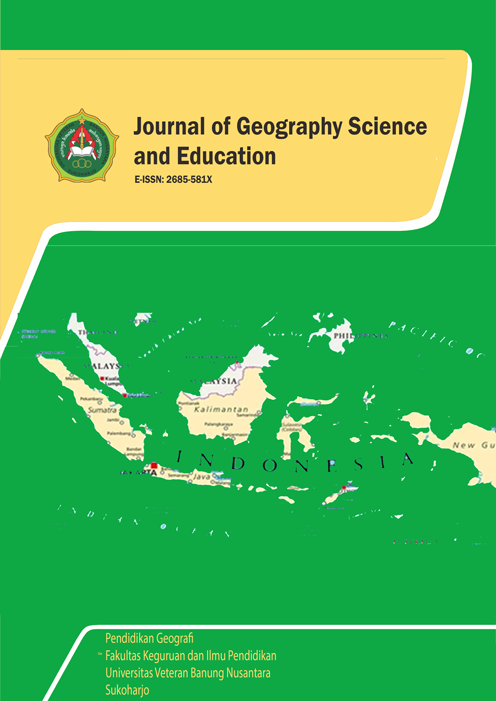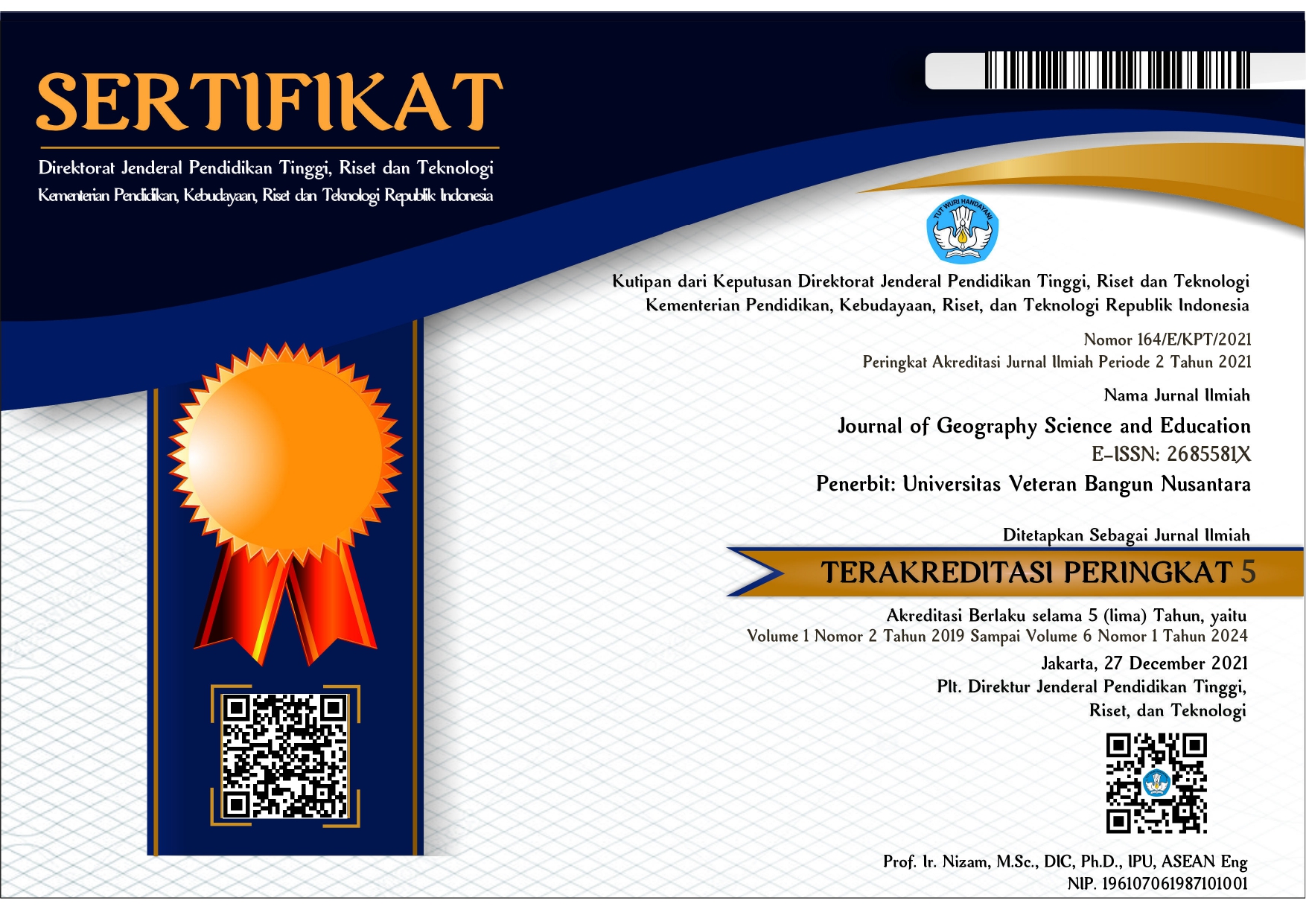Application of Blended Learning Methods in Increasing High School Students' Learning Interest in Sukoharjo
DOI:
https://doi.org/10.32585/jgse.v3i2.2077Kata Kunci:
Blended Learning Methods, Learning InterestsAbstrak
The Covid-19 pandemic caused a change in the education system that began from face-to-face meetings in the classroom to online-based to reduce the spread of the covid-19 virus. During online learning this causes the interest in learning learners decrease and there are several obstacles, namely: facilities, facilities, and infrastructure that are less supportive in teaching and learning activities, in addition to the lack of teaching methods carried out by educators in learning activities. This research uses descriptive research methods with quantitative approaches as well as primary data collection techniques from tests (questionnaires) and observation of online and offline learning activities in the classroom. Sma Negeri 1 Tawangsari has implemented a learning system offline and online. So that the application of blended learing learning methods is considered suitable in this system. Supported by the results of research shown in the second cycle that showed that offline learning activities are more desirable to learners because of the interaction between teachers and participants who are able to improve memory, reduce smartphone use that causes negative impacts on health, and short assignments with long-term collection.Unduhan
Referensi
Almanshur Fauzan, Ghony Djinaadi, M, Metoded Penelitian Kualitatif, Jogjakarta : Ar-Ruzz Media, 2016
Bruce Joyce, Marsha Weil, Emily Calhoun. 1998. Model of Teaching. Yogyakarta: Pustaka Pelajar
Graham, C. R. (2004). Blended Learning Systems: Definition, Current Trends, and Future Directions.
Husamah. (2014). Pembelajaran Bauran, Blended Learning. Jakarta: Prestasi Pustaka Publisher.
Ishak, Abdulhak. Deni dermawan. 2013. Teknologi Pendidikan. Bandung : PT Roda Kaya
Lalima, K. L. (2017). "Blended Learning : An Inovative Approach" . Universal Journal Of Educational Reserch.
Moelong. (2007). Metodologi Penelitian Kualitatif. Bandung: PT. Remaja Rosdakarya Offset.
Prof.DR.Sugiyono. (1999). Metode Penelitian Tindakan (Action Research). Retrieved from Universitas Negeri Padang Repository: http://repository.unp.ac.id/1621/1/MANSURDIN_4013_99.pdf
Rachmana, A., Sukrawan, Y., & Rohendi, d. (2019). Penerapan Model Blended Learning Dalam Peningkatan Hasil Belajar Menggambar Objek 2 Dimensi. Journal of Mechanical Engineering Education, Vol. 6, No, 2, hlm. 145-152
Rully, I., & Poppy, Y. (2017). Metodologi Penelitian Kuantitatif, Kualitatif dan Campuran untuk Manajemen, Pembangunan, dan Pendidikan. Bandung: Raja Grafindo Perkasa
Sagala, S. (2006). Konsep dan Makna Pembelajaran . Bandung: Alfabeta.
Sugiyono, P.D. (2017). Metode Penelitian Kuantitatif, Kualitatif, dan R&D. Bandung: Alfabeta
Utomo, S. W., & Wihartanti, L. V. (2019). Penerapan Strategi Blended Learning Untuk Meningkatkan Kemampuan Berpikir Kritis Mahasiswa Pada Era Revolusi Industri 4.0. Jurnal Teknologi Pendidikan, 30-44
Widiara, I. (2018). Blended Learning Sebagai Alternatif Pembelajaran Di Era Digital. Purwadita, 50-56
Unduhan
Diterbitkan
Cara Mengutip
Terbitan
Bagian
Lisensi
License and Copyright Agreement
In submitting the manuscript to the journal, the authors certify that:
- They are authorized by their co-authors to enter into these arrangements.
- The work described has not been formally published before, except in the form of an abstract or as part of a published lecture, review, thesis, or overlay journal. Please also carefully read JGSE's Posting Your Article Policy at http://pubs2.ascee.org/index.php/ijele/about/editorialPolicies#custom-5
- That it is not under consideration for publication elsewhere,
- That its publication has been approved by all the author(s) and by the responsible authorities – tacitly or explicitly – of the institutes where the work has been carried out.
- They secure the right to reproduce any material that has already been published or copyrighted elsewhere.
- They agree to the following license and copyright agreement.
Copyright
Authors who publish with Journal of Geography Science and Education agree to the following terms:
- Authors retain copyright and grant the journal right of first publication with the work simultaneously licensed under a Creative Commons Attribution License (CC BY-SA 4.0) that allows others to share the work with an acknowledgment of the work's authorship and initial publication in this journal.
- Authors are able to enter into separate, additional contractual arrangements for the non-exclusive distribution of the journal's published version of the work (e.g., post it to an institutional repository or publish it in a book), with an acknowledgment of its initial publication in this journal.
- Authors are permitted and encouraged to post their work online (e.g., in institutional repositories or on their website) prior to and during the submission process, as it can lead to productive exchanges, as well as earlier and greater citation of published work.
Licensing for Data Publication
Journal of Geography Science and Education use a variety of waivers and licenses, that are specifically designed for and appropriate for the treatment of data:
- Open Data Commons Attribution License, http://www.opendatacommons.org/licenses/by/1.0/ (default)
- Creative Commons CC-Zero Waiver, http://creativecommons.org/publicdomain/zero/1.0/
- Open Data Commons Public Domain Dedication and Licence, http://www.opendatacommons.org/licenses/pddl/1-0/
Other data publishing licenses may be allowed as exceptions (subject to approval by the editor on a case-by-case basis) and should be justified with a written statement from the author, which will be published with the article.
Open Data and Software Publishing and Sharing
The journal strives to maximize the replicability of the research published in it. Authors are thus required to share all data, code or protocols underlying the research reported in their articles. Exceptions are permitted but have to be justified in a written public statement accompanying the article.
The associated persistent identifiers (e.g. DOI, or others) of the dataset(s) must be included in the data or software resources section of the article. Reference(s) to datasets and software should also be included in the reference list of the article with DOIs (where available). Where no domain-specific data repository exists, authors should deposit their datasets in a general repository such as ZENODO, Dryad, Dataverse, or others.
Small data may also be published as data files or packages supplementary to a research article, however, the authors should prefer in all cases a deposition in data repositories.










